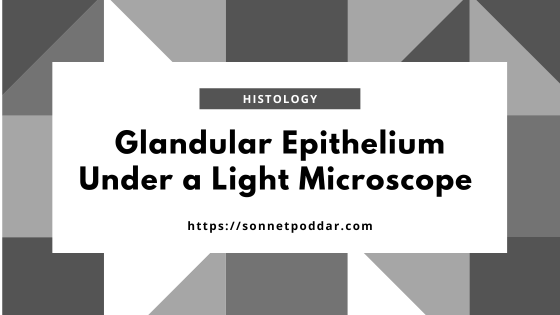Welcome. I hope you have completed the previous article, Identification of Surface Epithelium of Animals under Light Microscope. If not, I recommend reviewing it to learn the basics of surface epithelium. In this article, I will discuss the identification of glandular epithelium of animals under the light microscope. Before starting, ensure you understand permanent slide preparation and the use of a light microscope in the laboratory.
For a refresher on slide preparation and microscope basics, see the recommended links. This article is for beginners learning about glandular epithelium.
“This article is not for experts. This is only for the newbie. Thank you.”
First, we should know the definition of a gland. A gland is a structure that consists of the following –
Specialized surface epithelium is called glandular epithelium, derived from surface epithelium. Epithelium refers to a cell layer covering surfaces or lining cavities.
Consists of a complex duct system (They are also lined by surface epithelium)
They are located in connective tissue called stroma, which supports the gland.
Learning requirements:
You should know the following basics –
To understand glands, know these terms: parenchyma (active tissue of a gland) and stroma (supportive framework).
Parenchyma:
- Parenchyma includes secretory units and the gland’s duct system.
- Secretory unit (like acini or tubules, or tubule-acini)
- A complex duct system includes ducts such as intralobular (inside lobules), interlobular (between lobules), lobar (for each lobe), and the main duct (carries secretion outside the gland).
- In larger glands, lobules contain secretory units. Secretions flow from intralobular to interlobular, then lobar, then main ducts.
Stroma:
Stroma consists of the following structures –
Capsule: outer covering (collagen, elastic, reticular fibers) that provides support.
Septa: partitions from the capsule that divide the gland.
Internal supportive framework (connective tissue)
Classification of glandular epithelium
Classification of glandular epithelium is based on –
- Number of cells
- Site of secretion
- Morphological characteristics
- Nature of secretory products
- Mode of release of secretory products
Let’s review the classification of glandular epithelium with examples.
Based on the number of cells
Unicellular gland: it consists of a single secretory cell, like a goblet cell
Multicellular gland: it consists of more than one cell, like the thyroid gland, salivary glands
Based on the site of secretion
Exocrine glands are multicellular, have ducts, and transport secretory products to their site of use (e.g., sublingual salivary gland).
Endocrine glands are multicellular and lack ducts. Their secretions enter the bloodstream and reach target sites, for example, the thyroid gland.
Based on morphological characteristics
They are divided into two –
- Simple gland and
- Compound gland
They are again divided into the following –
Simple gland: Having one duct and divided into –
Tubular simple gland: straight (e.g., crypts of Lieberkühn), coiled (e.g., sweat glands), branched (e.g., uterine gland).
Acinar simple gland: single (e.g., urethral gland), branched (e.g., sebaceous gland).
Compound glands include tubular, acinar, and tubuloacinar types.
Example of these glands-
Tubular compound gland: Brunner’s gland of the duodenum
Acinar compound gland: parotid salivary gland
Tubuloacinar gland: submandibular gland
Refer to textbooks or class materials for more information on these glands.
Based on the nature of secretory products
They are divided into three –
- Serous acini – present in the parotid gland
- Mucous acini – present in the sublingual gland
- Seromucous acini (mixed gland) or serous demilune: present in the submandibular gland.
Now, let us identify these glands (serous, mucous, and seromucous glands).
Serous gland
- Presence of darkly stained acini with a narrow lumen
- Presence of spherical or oval-shaped nucleus at the center of the cell
- Presence of zymogen granules in the apical cytoplasm of the cell
- Presence of myoepithelial cell
- Presence of a well-developed duct system
- Serous glands are found in the parotid salivary gland and the exocrine part of the pancreas.
Mucous gland
- Presence of lightly stained acini with wide or larger lumen
- Presence of a flatten nucleus located at the basal part of the cell
- Presence of a mucinogen granule at the apical part of the cell
- Presence of myo-epithelial cell
- Presence of a poorly developed duct system
- Pure mucous glands are found in the sublingual salivary gland.
Seromucous gland or mixed gland
- Presence of both darkly stained serous acini and lightly stained mucous acini
- Presence of a serous cell located at the periphery of the mucous secretory unit (called serous demilune; crescent-shaped or half-moon-shaped)
- Presence of myoepithelial cells
- Example: The submandibular salivary gland is a seromucous gland, meaning it contains both serous (watery) and mucous (thick) secretions.
Myo-epithelial cells:
Myoepithelial cells lie between secretory cells and the basement membrane. They have features of both muscle and epithelial cells and help move secretions into ducts. The basement membrane is a thin fiber layer that supports the epithelium.
Base on the mode of release of secretory products
They are divided into the following –
- Merocrine gland
- Apocrine gland: mammary gland; sweat gland
- Holocrine gland: Sebaceous gland
- Cytocrine gland: Testis
Merocrine glands release products by exocytosis, sending materials out of the cell without losing cellular content.
Apocrine glands lose part of their cytoplasm during secretion (e.g., sweat gland).
Holocrine glands lose all cytoplasm during secretion (e.g., sebaceous gland).
Conclusion
Cytocrine glands transfer materials from one cell to another, such as sperm release in the testis.
This article provides core concepts for identifying glandular epithelium in animals using a light microscope.
If you need more information on animal glandular epithelium, refer to class lectures or textbooks. For basic connective tissue, contact me or watch for new articles. More on veterinary histology will follow.
This content may be updated or expanded with additional information, images, or videos in the future.
If you notice any errors above or have suggestions, please let me know in the comment box. Thank you.

